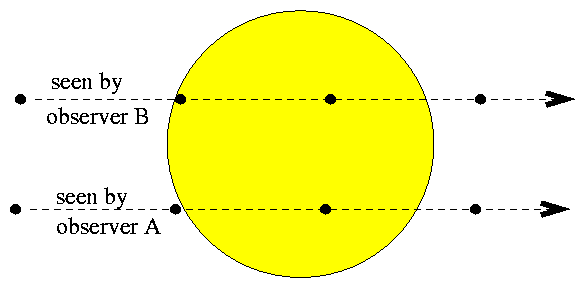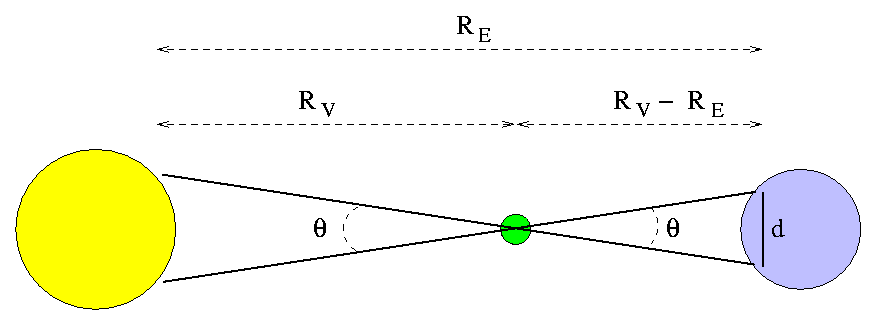Since links don't generate a lot of traffic and he was kind enough to post this under a Creative Commons license, we are printing it here to (hopefully) get it the audience it deserves. You can also find more information on transits of Venus at his website on transits of Venus and the links at its end. H/T to Enrico Uva for tracking this down.
***************************************
The simple example which follows is intended only to give you a flavor for the method; real astronomers in the eighteenth and nineteenth centuries included a host of complications and subtleties in their observations, measurements and analysis.
In the most basic terms, a transit of Venus permits scientists on Earth to draw a big triangle in the sky:

All information in this diagram has been ruthlessly altered for clarity.
People at different locations on Earth will see Venus move across the Sun's disk on slightly different paths.

The difference in apparent paths is so-o-o-o exaggerated in this diagram ....
So, in theory, finding the distance between the Earth and Sun -- the "solar parallax" -- is pretty simple:
- establish two stations on Earth, and measure the distance between them
- observe a transit of Venus from both stations
- measure the angular difference in Venus' path across the Sun's face
- use trigonometry to determine distance between Earth and Venus ....
- and then use the known relative distances to find the distance between Earth and Sun
"Observe" the transit with a planetarium program
Your job will be to observe the transit on a computer,using a planetarium program to simulate the view from two different locations on Earth.You should end up with two different pictures of Venus, taken simultaneously, which show a small displacement in its appearance relative to the Sun.
- Start the planetarium program The Sky
- Set your location to "Harrisburg, PA" (not far from Gettysburg) using the Data -> Site Information -> Location menu. Write down the latitude -- you'll need it later.
- Set the date and time to June 8, 2004, at 7:00 AM using the Data -> Site Information -> Date and Time menu
- Display your current location at the bottom of the screen by going to View -> Status Bar and choosing "Earth Location", "Date", "Time" and "Field Width"
- Now, you need to find the Sun. Zoom out and out and out until you can see the ecliptic, and look along it for the Sun. When you find it, right-click on the Sun and "Center" it. Then type Control-T to zoom in to a field of view about 1 degree wide, which shows the Sun and Venus nicely
- Lock onto the Sun by clicking on the Tracking Setup icon at the top of the screen; it's a yellow icon just to the right of the big red button icon. Choose Lock On to the Sun.
- You can move forward and back through time using the VCR-like controls near the top of the screen. The default time step is one hour, but you can switch to one minute for detailed work. Can you find the exact time of "Third Contact" as seen from Gettysburg? "Third Contact" is when Venus first touches the Sun's limb as it begins to leave the Sun
Once you've found the time of third contact, make an observation by printing a picture of the screen:go to the File -> Print menu.
Congratulations! You have succeeded in making one of the two crucial measurements.
The next step is to observe the same event from a different location on Earth. Let's pick Quito, Ecuador, which is very nearly due south of Harrisburg and Gettysburg.
- In the Data -> Site Information -> Location menu, choose Open ... and pick the "World Observatories.loc" file. It contains geographical information for cities around the world. Choose Quito, Ecuador. Write down its latitude.
- When you Apply the new location, you should see Venus shift a tiny bit relative to the Sun. Compare the view on the screen to your printout of the view from Harrisburg to verify that there is a change. Make sure that the time is the same as that of your observation from Harrisburg.
- Print out the view from Quito.
Now you have two simultaneous measurements from two locationson Earth!
Measure the parallax angle
Just how large is the apparent shift in the position of Venus?This shift is called the "parallax angle", or "parallax" for short.Because Quito is nearly due south of Harrisburg,the shift in Venus' position should be nearly due north/south(which will simplify the analysis).
Your printouts may show many stars in addition to Venus and the Sun, but those didn't appear in real photographs, of course.To be fair to astronomers of yore, use the Sun as the only point of reference.On this date, it has a diameter of just over half a degree.To be precise, the diameter of the Sun during this transit is 1891 arcseconds. There are 60 arcseconds in one arcminute, and 60 arcminutes in one degree, which means 3600 arcseconds in one degree. Astronomers use arcseconds to measure smallangles; it's more convenient to write "10 arcseconds"than "0.00277 degrees."
- Use the Sun as a yardstick: it is 1891 arcseconds in diameter
- Measure the north-south shift of Venus as seen from the two locations
- Express this shift in arcseconds and in degrees
Do a little trigonometry
You have measured the parallax angle theta.If you can figure out the baseline distanced between the two locations on Earth,then you can use trigonometry to find the distance between Venus and Earth.
So, what is the distance d between Quito and Harrisburg?
- Method 1: draw a circle representing the Earth, mark the location of each city (Harrisburg at latitude +40, Quito at latitude 0), and consider various triangles ....
- Method 2: hope that Google can help ...
Okay, so you have the distance d.How can that help you find the Earth-Venus distance?If the triangle defined by the parallax angle theta were a right triangle, it would be easy;but, alas, it's an isoceles triangle, not a right triangle.What can you do?
- Hint: split the isoceles triangle into two equal halves
Great! Now use your trig skills. What is the distance between Earth and Venus?
Calculate the length of the Astronomical Unit
At this point, you know the distance between Venus and Earth during the transit;but what we really want is the Astronomical Unit:the distance between the Earth and Sun.As you may recall, Kepler and other astronomers had figured out the relative sizes of the planetary orbits:
| Planet | Orbital period | Orbital semi-major axis |
| (years) | (AU) | |
| Mercury | 0.241 | 0.387 |
| Venus | 0.615 | 0.723 |
| Earth | 1.0 | 1.0 |
| Mars | 1.88 | 1.52 |
| Jupiter | 11.86 | 5.20 |
| Saturn | 29.46 | 9.55 |
calculate the size of the Astronomical Unit.
- Based on your value for the Earth-Venus distance, and the orbital radii
shown above, calculate the size of the Astronomical Unit.- How does it compare to the currently accepted value?
Copyright © Michael Richmond.
This work is licensed under a Creative Commons License.






Comments